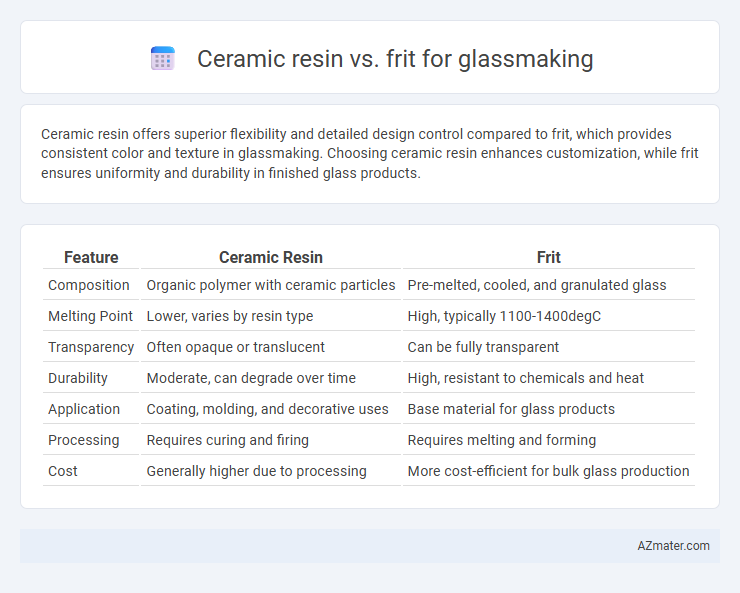Ceramic resin offers superior flexibility and detailed design control compared to frit, which provides consistent color and texture in glassmaking. Choosing ceramic resin enhances customization, while frit ensures uniformity and durability in finished glass products.
Table of Comparison
| Feature | Ceramic Resin | Frit |
|---|---|---|
| Composition | Organic polymer with ceramic particles | Pre-melted, cooled, and granulated glass |
| Melting Point | Lower, varies by resin type | High, typically 1100-1400degC |
| Transparency | Often opaque or translucent | Can be fully transparent |
| Durability | Moderate, can degrade over time | High, resistant to chemicals and heat |
| Application | Coating, molding, and decorative uses | Base material for glass products |
| Processing | Requires curing and firing | Requires melting and forming |
| Cost | Generally higher due to processing | More cost-efficient for bulk glass production |
Introduction to Ceramic Resin and Frit in Glassmaking
Ceramic resin and frit are essential materials in glassmaking, each contributing unique properties to the final product. Ceramic resin serves as a binder that enhances adhesion and durability during the glass shaping and firing processes, while frit consists of pre-melted glass particles that improve melting behavior and chemical stability. Understanding the roles of ceramic resin and frit helps optimize clarity, strength, and surface finish in advanced glass manufacturing.
Composition and Properties of Ceramic Resin
Ceramic resin in glassmaking is a polymer-based material composed primarily of siloxane or silicone resins combined with inorganic fillers, providing excellent adhesion and thermal stability during the firing process. Its unique composition allows for precise control over viscosity and curing behavior, resulting in smoother surfaces and higher definition of patterns compared to frit, which is a finely ground glass powder with a crystalline structure. Ceramic resin's organic-inorganic hybrid nature ensures superior flexibility and durability, making it ideal for intricate designs and applications requiring fine detail and surface quality.
Understanding Frit: Types and Applications
Frit in glassmaking refers to a pre-melted and quenched glass powder used to control composition and minimize volatilization during melting, enhancing product consistency and quality. Common types of frit include soda-lime, borosilicate, and lead frits, each tailored for specific applications such as enameling, glazes, or specialty glass production. Its applications range from glass coatings and colorants to improving thermal and chemical resistance in ceramic and glass products, making it a critical component compared to ceramic resin, which primarily serves as a binder in composite materials.
Comparative Analysis: Physical Characteristics
Ceramic resin offers superior flexibility and impact resistance compared to frit, which is more rigid and brittle due to its glassy composition. Frit provides higher melting points and better thermal stability essential for permanent glass fusing, whereas ceramic resin softens at lower temperatures, affecting durability. The porous structure of ceramic resin allows for enhanced adhesive properties, whereas frit's dense, glass-like texture ensures long-lasting, clear finishes in glassmaking applications.
Impact on Glassmaking Techniques
Ceramic resin offers enhanced mold precision and flexibility, enabling more intricate glass shapes and detailed textures compared to traditional frit, which is primarily used as a colorant and additive in glassmaking. The use of ceramic resin impacts glassmaking techniques by allowing faster prototyping and reducing kiln firing times due to its lower thermal mass. In contrast, frit affects glass appearance and surface finish but requires careful control of melting and compatibility during the glass fusion process.
Color Development: Resin vs Frit
Ceramic resin enables intense, vibrant color development in glassmaking by providing uniform pigment dispersion and enhanced bonding within the glass matrix. Frit offers superior color stability due to its pre-melted state, resulting in consistent hue and reduced risk of color bleeding during firing. Both resin and frit play crucial roles in achieving precise color effects, with resin favoring vivid saturation and frit ensuring long-term durability.
Firing Temperatures and Process Compatibility
Ceramic resin typically requires lower firing temperatures, around 600-800degC, making it compatible with a wide range of substrates and enabling faster firing cycles. Frit, on the other hand, melts at higher temperatures, generally above 800degC, which demands longer, more controlled heating to ensure proper fusion and surface durability. The choice between ceramic resin and frit hinges on process compatibility with kiln schedules and the thermal expansion characteristics of the glass being produced.
Cost Implications in Production
Ceramic resin offers a cost-effective solution in glassmaking due to its lower raw material expenses and simpler processing compared to frit, which requires high-temperature melting and quenching. Frit production involves significant energy consumption, increasing overall operational costs and affecting scalability. Choosing ceramic resin can reduce upfront investment and enhance production efficiency while maintaining acceptable quality for certain glass applications.
Environmental and Safety Considerations
Ceramic resin in glassmaking offers lower VOC emissions and reduced hazardous waste compared to traditional frits, enhancing workplace air quality and minimizing environmental impact. Frits often contain heavy metals and fluxing agents that can pose health risks during handling and increase landfill toxicity, necessitating stringent disposal protocols. Choosing ceramic resin promotes safer manufacturing processes by reducing toxic exposure and supporting sustainable glass production practices.
Choosing the Right Material for Your Glassmaking Project
Ceramic resin offers enhanced flexibility and precision for detailed glassmaking projects, providing superior control over texture and color blending compared to frit. Frit, composed of crushed glass particles, is ideal for achieving vibrant, consistent color effects and smooth surface finishes in kiln-formed glass. Selecting between ceramic resin and frit depends on project complexity, desired visual outcome, and firing temperature compatibility to ensure durability and aesthetic quality in the final piece.

Infographic: Ceramic resin vs Frit for Glassmaking
 azmater.com
azmater.com